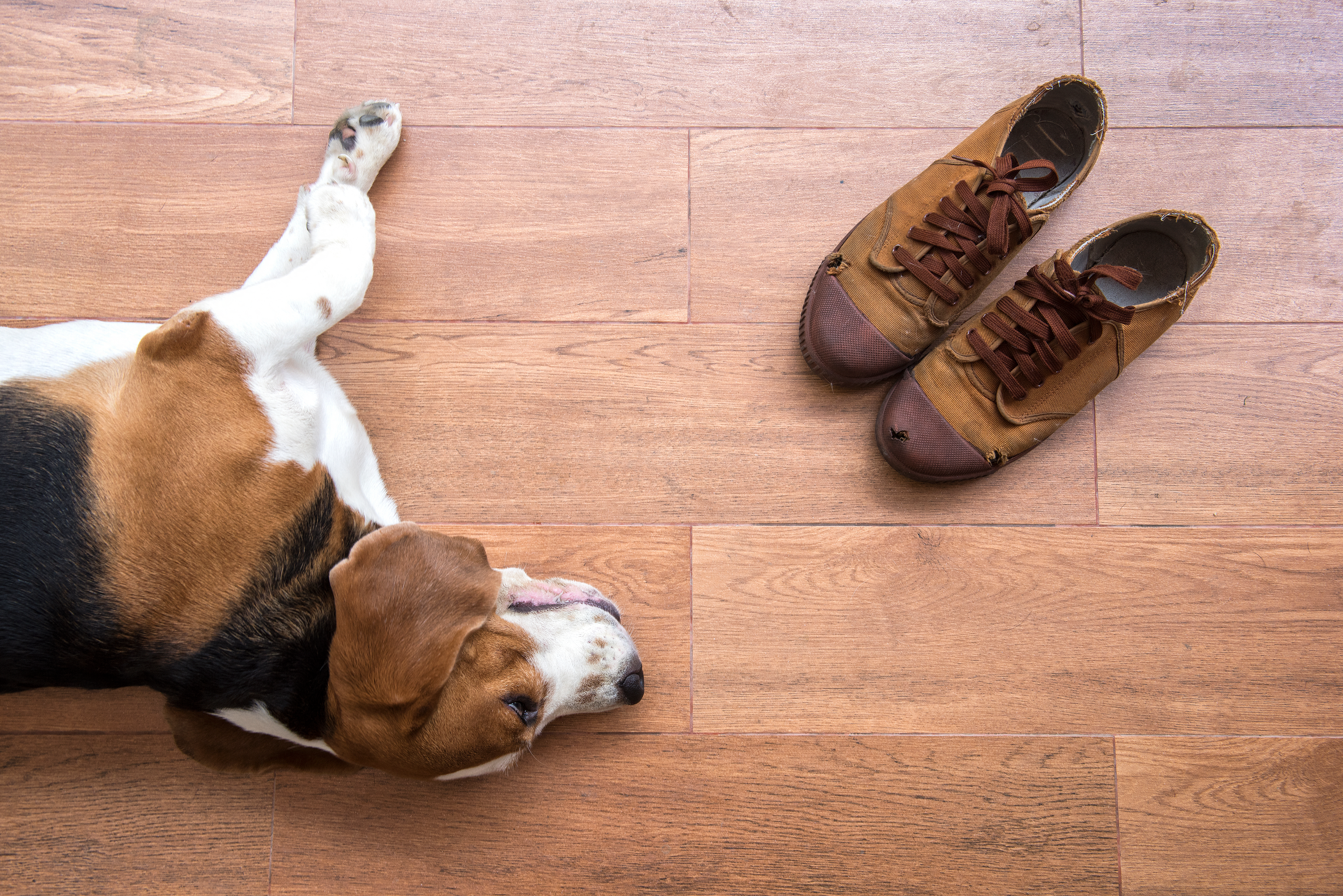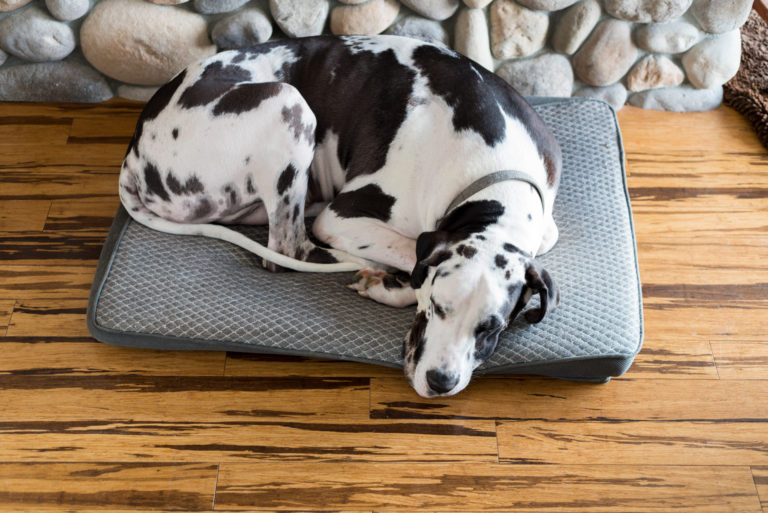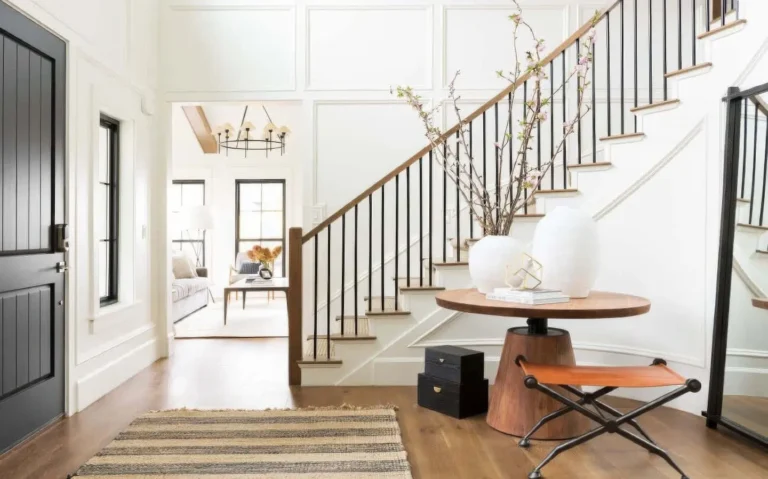This post may contain references or links to products from one or more partners of our parent company and/or subsidiaries of our parent company. For more information, visit this page.
September 16, 2022
Are You Considering Engineered Wood Flooring for Your Home?
Simply put, engineered hardwood is a type of real wood flooring made up of a composite core (usually plywood) with a solid wood veneer on top. But really, there’s so much more to it than that.
After all: you don’t need to be a flooring expert to know that there are tons of wood flooring types on the market. But—you may feel like you need to be an expert just to understand the differences between solid hardwood, engineered hardwood, and all the other varieties they offer!
And it’s true—when it comes to wood, engineered hardwood flooring may be one of the most misunderstood flooring options. That’s why today, we’re going to dive into everything you need to know about engineered wood.
We’re going to talk about what exactly engineered hardwood is (and what it isn’t); we’ll weigh its advantages and disadvantages, answer some frequently asked questions about it, and see how it compares to other types of flooring like solid hardwood, laminate, and even products from some of the best vinyl plank flooring brands.
What is engineered hardwood flooring? Let’s find out together!
At the Most Basic Level, What is Engineered Hardwood Flooring?
Let’s get this out of the way first. Engineered hardwood flooring is real wood flooring.
It might be on lots of faux wood flooring lists (including our own), but that’s just because people often think of it as a different material. But really, it’s just a different type of real wood flooring.
What’s the Difference Between Solid Hardwood and Engineered Hardwood?
Solid hardwood is one piece of wood throughout.
Engineered hardwood, on the other hand, is made of two layers of wood fused together. These are a high-strength wood composite core (sometimes plywood and sometimes oriented strand board), and a thin layer—or “veneer” of solid hardwood on top. You’re probably familiar with this thin layer of hardwood veneer on furniture.

What Makes for the Best Engineered Hardwood? What Should You Look For?
The best engineered wood flooring products will have three things in common.
- They will have a thicker veneer layer (we’ll discuss why further down).
- The base will be made of plywood rather than OSB (oriented strand board).
- The plywood base will have more plies for extra durability. Some products have as few as 3 plies, but we recommend at least 5–7. Some of the best engineered wood flooring brands feature 10 plies or more.
What Does Engineered Hardwood Flooring Mean?
Engineered hardwood flooring planks are literally engineered—aka manufactured—from different types of wood.
Together, they create one full flooring plank. Yes, it is manufactured—but all the components are natural and organic. They are 100% wood. That’s it. No additives or imitation flavors here.
Pro tip: in the flooring world, the word “engineered” usually just means “made out of more than one material”. For example, EVP flooring (aka engineered vinyl plank) is simply vinyl flooring that has a rigid core (which is often infused with some other material). SPC flooring, for example, features a limestone-infused core for extra durability.
Once Again: What is Engineered Hardwood? It’s Real Wood
We can not stress this enough. Engineered hardwood is not fake wood flooring. It is made from real wood. But instead of one solid plank, it’s two layers of different woods fused together.
So Why do Engineered Hardwood Floors Exist?
If the answer to the question “what is engineered hardwood” is simply “another type of hardwood”, then why do these floors exist?
Well, there are many ways that engineered hardwood can add value to the world of flooring. Most importantly, can do things that solid types of wood flooring can’t. We’ll go through all of them in these engineered wood pros and cons.
What is Engineered Hardwood: The Pros and Cons
What is engineered hardwood’s biggest advantage over solid wood? Well, there are a number of them—but there are some disadvantages of engineered wood as well. Let’s talk about the positive stuff first.
Best Brands of 2024
The Benefits of Engineered Hardwood Flooring
Engineered Hardwood is More Resistant to Environmental Changes than Solid Wood
Engineered hardwood is not affected by humidity and moisture in the same way that solid hardwood is.
This may not sound like a huge deal, but it really, really is. In fact, a simple answer to the what is engineered hardwood question could be “a more stable type of wood flooring”.
So: in what ways is engineered wood flooring more stable? Well, for one, it won’t shrink, expand, or warp with changes in temperature and humidity the way solid hardwood will. Translation: if you need the most durable wood flooring for any given room, you’re more likely to find it in an engineered option.
And That Means it Can Go Almost Anywhere
Want to put ash flooring in your basement? Oak flooring in your garage? Need water-resistant wood flooring for your kitchen? You’re going to want to go with engineered hardwood.
Basements, garages, and kitchens are almost always no-fly zones for solid hardwood. There’s simply too much moisture (especially if you have a concrete subfloor). Engineered wood flooring, on the other hand, can go in all of these places
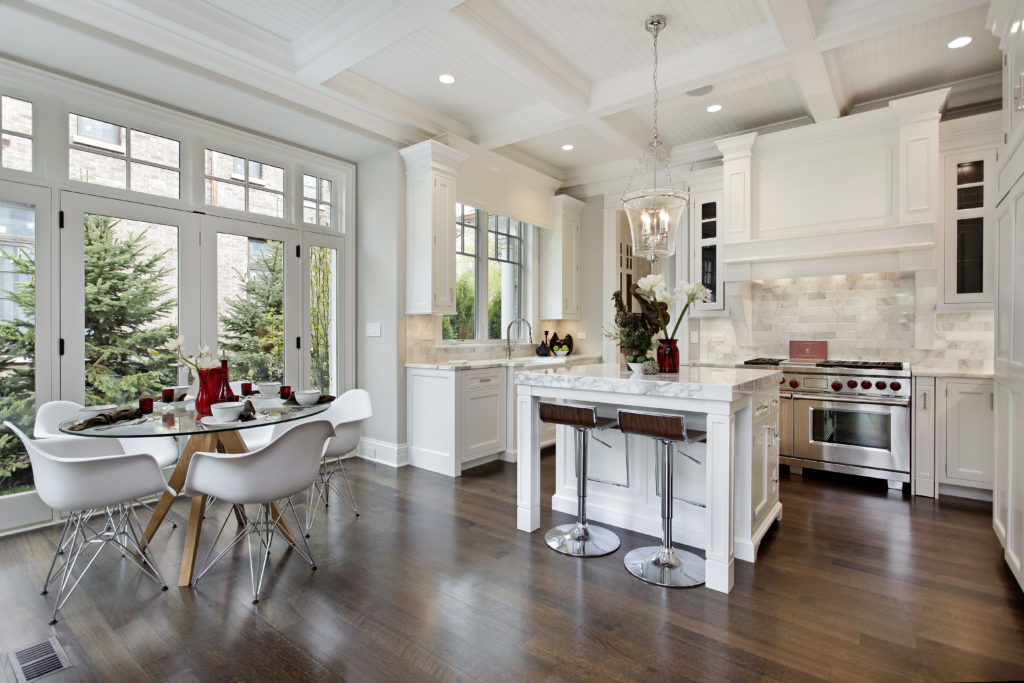
Of course, that doesn’t mean you should use it in areas that are going to get soaked (like mudroom flooring). For that, we’d recommend a waterproof alternative like PVC flooring or wood-look tile. But overall, it’s a much better choice for moisture-prone areas.
You Can Install it Directly Over Subflooring
What is engineered hardwood’s biggest installation perk? It can go directly over subflooring! And you don’t need to buy the very best engineered wood flooring for that, either—you can put almost any type of engineered hardwood flooring over a subfloor (and if you’re confused on the difference between underlayment vs. subflooring, read up on that before moving on!)
Solid wood needs special underlayments in order to be put on a subfloor. This makes installing engineered wood cheaper and less labor-intensive than installing solid hardwood.
You Can Even Install it Over Concrete Subflooring
Engineered hardwood flooring can be installed on most grade levels with a protective moisture barrier. It can even be laid right over existing concrete. No special underlayment needed! How easy is that?
Again, however, we’d stress that no matter what type of flooring you install, you need to use a moisture barrier if it’s going directly on top of concrete. Even the best vinyl plank flooring products need this, and they’re totally waterproof!
Engineered Hardwood Flooring is Often Easier to Install than Solid Hardwood
And speaking of installation: it’s often easier to install engineered hardwood flooring than solid.
That’s because there are a variety of ways to install engineered products, whereas solid options are a bit more traditional. Solid wood has to be nailed or glued to a subfloor. Engineered hardwood, on the other hand, can be nailed, stapled, glued, or (the easiest way) installed as a floating floor.
What is a floating floor? It’s flooring that’s only attached to itself, rather than to the subfloor. It uses click-together flooring planks that snap together like puzzle pieces, making for an easier do-it-yourself flooring job (or a quicker professional installation).
There are some disadvantages of floating floors, but they’re minimal—especially if you use a proper underlayment.
Translation: engineered hardwood flooring can be some of the easiest flooring to install!
And That Means Engineered Hardwood Flooring Costs Less to Install, Too
For the reasons we just mentioned, the average cost to install engineered hardwood floors is lower than it is for solid hardwood.
So if you’re looking for ways to reduce the cost to replace carpet with hardwood or your older wood floors, engineered hardwood flooring may be the way to go.
Plus, it Can Make Exotic Hardwoods More AffordablePlus,
If you think that you don’t have the budget for solid hardwood floors, don’t give up hope! You don’t need to run to imitation wood flooring just yet.
Wood flooring costs vary depending on the hardwood flooring species you buy. But: engineered hardwood flooring uses both solid wood and plywood—meaning that you won’t have to pay as much for exotic species when you opt for engineered products. Because they use less of the precious exotic wood! After all—what is engineered hardwood flooring if not a more cost-effective type of flooring?
Engineered Products Come in Wider Plank Sizes
Thanks to its ability to withstand environmental fluctuations without warping, engineered hardwood flooring makes super wide-plank flooring possible. Once upon a time, wide-plank wood flooring was only truly possible with softer woods such as pine flooring douglas fir flooring. But now, you can get these widths in all types of prefinished hardwood flooring.
Why is this so awesome? Well, some woods need wide planks to truly demonstrate their potential.
If you’ve spent any time looking at the pros and cons of hickory flooring, you’ll know it has a very, very distinct grain. Some people see this as a disadvantage of hickory flooring, but we think it looks amazing. It just needs a wide plank to show off its unique personality and natural beauty!
Engineered Hardwood Flooring is More Environmentally Friendly
What is engineered hardwood’s biggest benefit? It depends on who you ask. But in our opinion, we think the answer might be that engineered hardwood flooring is a more eco-friendly flooring choice.
By using composite wood in its core layer, engineered hardwood flooring repurposed wood that would otherwise go to waste—and goes a long way towards creating a more sustainable wood flooring ecosystem.
That isn’t to say that solid hardwood is bad, or that buying hardwood floors that aren’t engineered is irresponsible. It just means that engineered wood flooring is the more environmentally-friendly flooring option.
Fun fact: if you’ve looked into the pros and cons of cork flooring, you might know that engineered wood flooring isn’t the only flooring that uses “waste” material. Cork flooring is made of the stuff left over from wine cork production! And another fun fact: most disadvantages of cork flooring can be solved by buying—you guessed it—engineered cork flooring!
There are Tons of Engineered Products (Not Just Hardwood)
Engineered products aren’t limited to what people consider “hardwoods”, either. By pairing a high-strength composite core with a solid veneer, you can get the best of both worlds with tons of different materials.
Besides many of the best cork flooring products, you can also find things like hemp flooring in an engineered construction. Love bamboo? Check out the pros and cons of engineered bamboo flooring. The list goes on.
And of Course, Engineered Hardwood is Super Durable
It’s probably clear by now, but what is engineered hardwood if not a super durable version of solid hardwood?
Looking for the best wood floorings for dogs? How about sunroom flooring that won’t warp from the shifts in temperature? Maybe hardwood that can stand up to the hot-and-humid summers of Florida and not warp when you turn on the air conditioning? Engineered hardwood is probably your best bet. Most flooring has a wear layer on top to help increase durability and make it last longer.
Disadvantages of Engineered Hardwood Flooring
Nothing in this world is perfect—not even engineered hardwood flooring. And it’s true: there are some significant engineered wood flooring disadvantages you need to know about. Here are some of the most important ones.
Engineered Hardwood Can Only Be Refinished A Few Times (Though This Isn’t Generally an Issue Anymore)
Because engineered hardwood only has a thin veneer of solid wood, it can only be sanded down and refinished a few times. And unless you buy one of the best engineered wood floors, you might not be able to refinish it at all.
Solid wood flooring, on the other hand, can be sanded down and refinished indefinitely.
Certain wood floor patterns don’t lend easily to refinishing, either. If your floors are hand-scraped or wire-brushed, they may be too textured to re-sand. Additionally, certain wood floor designs — herringbone parquet flooring, for instance — can be difficult to refinish due to the different wood grain directions.
Why is this not an issue anymore? Today’s prefinished hardwoods generally come with an extremely durable, UV-cured, aluminum oxide factory finish. Finishes like this can’t be replicated at home—but generally, they never need to be. And that means you don’t have to worry about veneer layer thickness, because you’ll never have to sand through to the veneer anyway.
The most you’ll have to do is “resurfacing”, which is just a quick abrasion and a new coat of polyurethane. And boom—good as new.
Engineered Hardwood Flooring Can Scratch
Though it may be durable, engineered hardwood still has some of the same limitations as solid hardwood. One of the biggest: it isn’t particularly scratch-resistant flooring, since it’s still, well, wood! A good finishing coat can help, but it won’t prevent all damage.
Engineered Hardwood is Not Waterproof
Although engineered hardwood handles moisture better than solid hardwood does, it isn’t waterproof. If you need a floor that can handle piles of wet towels or frequent spills or puddles, you may want to look into the pros and cons of buying tile vs. wood flooring.
Or just go totally synthetic and get some waterproof vinyl flooring that looks like wood instead!
But we get it: if you have your heart set on a wood-look bathroom or laundry room (and want a natural surface), we’d consider some hardwood floor alternatives like Mohawk’s waterproof RevWood—or one of the many porcelain types of tile that look just like real wood.
What is Engineered Hardwood: FAQs
We’ve covered a lot of information about what engineered hardwood flooring is, but we know you still have questions. Let’s fill in those gaps for you!
How Thick is Engineered Hardwood Flooring?
The overall thickness of an engineered hardwood plank will be either the same as or slightly thinner than a solid hardwood plank. Planks of engineered hardwood are usually ⅜”–½” thick, and sometimes as much as ¾” thick.
This can make it a more attractive option if solid hardwood would raise your floors up too high. A thinner plank can keep it level with your threshold.
Is Engineered Hardwood Flooring Waterproof?
Sadly, engineered wood flooring is not waterproof. While it is able to withstand moisture better than solid hardwood, it is still made of wood. It won’t do well in standing water or in areas that take water damage. It can sustain the humidity fluctuations of a basement, for example, but if your basement is flood-prone it isn’t a good match.
What Styles of Engineered Hardwood are There For Your Home?
There are so many styles to choose from when it comes to engineered hardwood flooring. Most of the best hardwood species are available, along with a variety of finishes like hand-scraped and wire-brushed styles. Looking for a classic floor? Check. Something exotic like ebony flooring? Sure. How about a modern design? Engineered hardwood flooring has you covered.
How to Tell the Difference Between Engineered Hardwood and Solid Hardwood
Once your new wood floor is installed, you won’t be able to tell whether it’s engineered or solid hardwood just by looking at it. From above, they’re exactly the same: good ol’ hardwood.
The only real way to see the difference between the two types of planks is by looking at their cross-sections. When you look at a plank of engineered hardwood, you’ll see the layers that comprise it. When you examine solid hardwood flooring, all you’ll see is… solid hardwood.
How Long Can an Engineered Wood Floor Last with Regular Maintenance?
When you take care of your engineered wood floor, it can last quite a while. Engineered wood flooring is real wood flooring, and it’s more durable than laminate flooring.
Regular maintenance of sweeping and cleaning with a wood cleaner will help keep it looking nice. You can protect the engineered floor by keeping shoes off of it, using felt pads on furniture and taking other protective measures. If maintained properly, these floors can last as long as 50 years.
Which is Better: Solid or Engineered Wood Flooring?
There are advantages to both types of flooring. It’s important to closely examine your personal needs and flooring goals.
Where will you be installing the floor? What are your expectations as far as refinishing? What’s your budget? At the end of the day, this question comes down to one thing: you.
Engineered Hardwood Flooring vs. Laminate Flooring
Both engineered hardwood and laminate flooring are popular and affordable flooring options. However, there are some major differences when it comes to laminate vs. hardwood floors.
Spoiler alert: laminate flooring is not real wood flooring. It is a very realistic image of wood laid over a piece of fiberboard. There is no real wood veneer involved. It cannot be refinished or resurfaced.
That may not worry owners too much, though, since the top layer is incredibly durable and difficult to scratch or dent.
In fact, the only real comparison in terms of hardness is bamboo flooring vs. laminate flooring. The best bamboo flooring has an insane hardness rating. Who knew that grass flooring could be so strong? Oh, and PS: you can even refinish bamboo flooring the same as other hardwoods. Win!
Is Engineered Flooring the Same as Laminate Flooring?
Nope! Laminate flooring is not organic. And what is engineered hardwood again? A real wood floor!
Plus, because the top layer of laminate is manufactured from man-made materials, it can come with the danger of VOCs. These are toxic chemicals that “off-gas” into your home and can cause health problems. There are non-toxic laminate flooring products out there, however, and it would be a good idea to do research into these products if you are considering laminate.
Because there is no hardwood involved, laminate is a less expensive option. On the other hand, it adds little value to your home, so that is something to keep in mind. You can read some Pergo reviews to decide if laminate is worth your consideration.
Engineered Hardwood Flooring vs. Vinyl Plank Flooring
If you compare vinyl plank vs. laminate flooring, you’ll find that the materials are very similar.
They’re both human-made products containing no real hardwood, designed to save you money. They may be durable, but unlike engineered hardwood flooring, they’re not natural. And again, what is engineered hardwood? Real wood flooring.
Sorry, we simply can’t stress that enough.
Either way, while the best types of vinyl flooring are difficult to tell apart from actual wood flooring, they’re made of PVC—plastic. And that means the disadvantages of vinyl plank flooring also include a propensity to contain VOCs. And while there are low-VOC vinyl flooring options out there, they’re relatively few and far between.
Either way, vinyl is cheaper than engineered hardwood. Even the cost to install vinyl plank flooring is cheaper, at roughly $1–$4 per square foot (as opposed to approximately $5 per square foot for mid-range engineered hardwood).
What to Look For When Buying Engineered Hardwood
As we said before, there are three components you should be keeping in mind when shopping for the best engineered wood flooring: the thickness of the veneer layer, a plywood core, and the number of plies in that core. Each one of these is firmly in the “more is better” camp.
Also: the harder the veneer layer is, the more durable the plank is going to be. This not only refers to the finish used to coat the wood, but also the type of wood that the veneer is made of in the first place. A harder wood, such as or teak flooring, will likely last longer.
Of course, harder woods may increase your cost to refinish hardwood flooring. But given that they’ll also ensure it takes longer to get to the point of needing a refinish in the first place, that’s a problem you want to have.
But again: if you opt for prefinished hardwood, you don’t really need to worry about refinishing it (which means you don’t really need to worry about veneer thickness, either).
Where Can You Install Engineered Hardwood Flooring?
While it wouldn’t make any rational person’s list of outdoor flooring options, engineered hardwood flooring can go practically anywhere. Anywhere it’s not going to be literally soaked with water, that is. Basements, kitchens, half-baths, garages—it’s all fair game.
Trying to decide between carpet or hardwood in the bedroom? Go with engineered wood. Unless you specifically buy a low-VOC carpet, you might be breathing in fumes. Engineered hardwood is pretty, it’s better for resale value, and it’s often a more low-VOC flooring choice. Win-win-win.
Can You Install Engineered Hardwood on Top of Other Flooring?
Engineered hardwood floors can be installed on top of any hard surface that’s level. Lay it over vinyl? Over tile? Even over concrete? Yes, yes, and YES!
Can You Use Engineered Hardwood Flooring in a Basement?
We’ve said this before, but we’ll say it again—you absolutely can use engineered wood flooring in a basement. As long as it’s not going to get soaked (and as long as you put down a vapor barrier first the way you would with any other floor), you’re made in the shade.
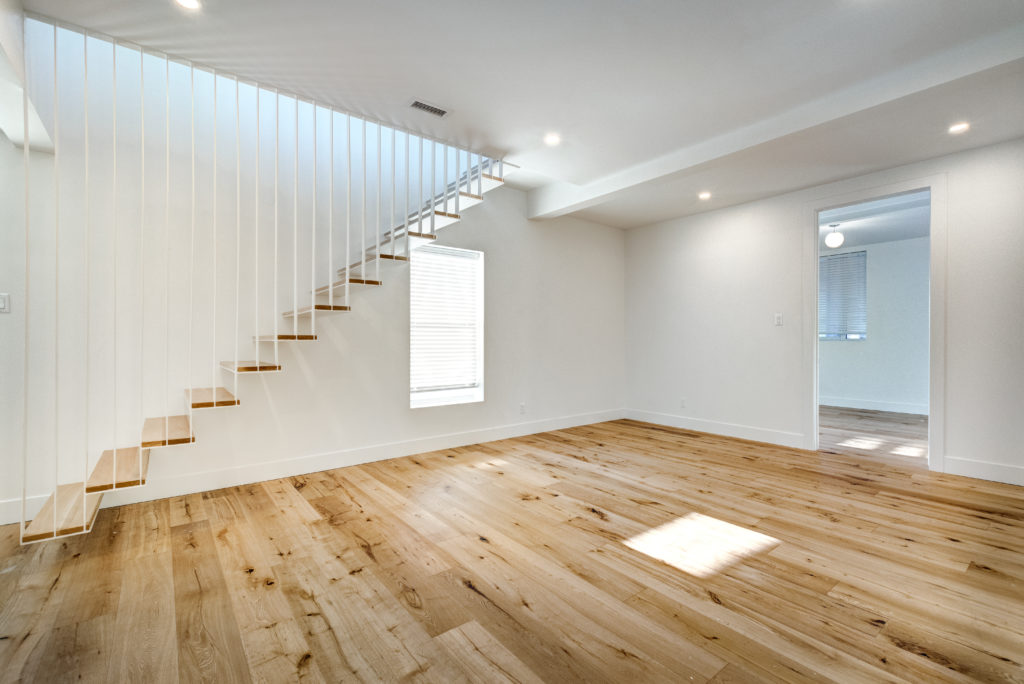
Translation: you don’t have to pay a premium to pour and texture concrete flooring to look like solid wood flooring if you want wood-look floors in your basement. Just get engineered hardwood!
How Do I Find the Best Engineered Wood Flooring?
As we’ve said multiple times above, the best engineered wood flooring products will have three things in common.
- A thicker veneer (so the floor can be refinished—but this is only important if you don’t opt for a factory finish)
- A plywood core rather than OSB (plywood is usually the stronger of the two)
- At least 5–7 plies in the base.
- A thicker veneer (so the floor can be refinished—but this is only important if you don’t opt for a factory finish)
- A plywood core rather than OSB (plywood is usually the stronger of the two)
- At least 5–7 plies in the base.
And how do you find these products, precisely? Go to a top-rated flooring store near you rather than a box store. No offense to the box store clerks, but they don’t really know what they’re doing—after all, they work in a massive home improvement warehouse. Flooring isn’t their forte. Local flooring stores are your best bet for answering any what is engineered hardwood questions, from plies to veneer thickness.
What’s the Best Thickness for Engineered Hardwood Flooring?
On the subject of thickness: the ideal width of your engineered hardwood planks is dependent on your home’s needs, as well as the core layer and veneer thickness.
For example, if you’re putting engineered hardwood over existing flooring, you’ll probably want a thinner product so as not to raise the level of your floors too much!
Overall, though, it’s better to have a thicker core for dimensional stability (especially if it’s plywood, since thicker means more plies)—and as we stated above, a thicker veneer is better for refinishing purposes, too.
Engineered Hardwood vs. Solid Hardwood Cost
One element we haven’t touched on much in our what is engineered hardwood guide: the cost difference between engineered wood flooring and solid wood flooring.
Obviously, it depends on the wood species you’re going with, etc.—and there will be a big price difference between the best hardwood floor brands and lower-quality budget options.
But in general, prices are relatively similar for domestic hardwoods, especially common ones like oak. The big cost differences you’ll see are between expensive, exotic hardwood species—since again, engineered hardwood uses less of that precious wood.
So What is Engineered Hardwood? It’s a Fantastic Type of Real Wood Flooring
So, what is engineered hardwood? It’s one of the two types of wood flooring, and it can do a lot of things that solid hardwood can’t. In fact, many of the best hardwood floors are made of engineered wood flooring!
But at the end of the day, your flooring choice really needs to fit your needs and your style. Only you can make that final call. Need a little more help making your choice? Find a flooring store near you to talk to an expert who can help guide your flooring journey along! Or, for more info, read up on:
- A Guide to Peel-and-Stick Carpet Tiles (& 9 Reasons They’re Amazing)
- LifeProof Vinyl Flooring Reviews: Is It Worth It?
- Tile vs. Laminate Flooring: The Pros and Cons
- Linoleum vs. Laminate vs. Vinyl: Differences, Pros, & Cons
- Is the Cork Flooring Lowes Sells Actually Worth Buying?
- Can You Bleach Wooden Floors? Yes! Here’s How.
- Magnetic Flooring: Everything You Need to Know
- Snap-Together Tile Flooring: Is It Right for You?
- Carpet vs. Laminate: The *Real* Pros & Cons
- SmartCore Flooring Reviews: Is it Worth it?
- NuCore Flooring Reviews: Is It Worth It?
About The Author
Bo Arnold
September 7, 2022
Associate Copywriter at FlooringStores (and its parent company, Broadlume), Bo is an avid traveler, former English teacher, and unashamed extrovert. When he’s not writing, you'll usually find him at a local hardware store looking for his next project.
